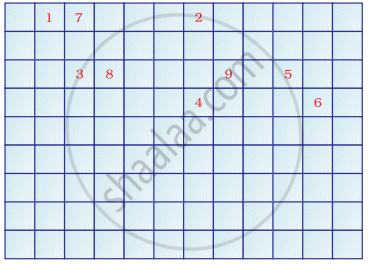Advertisements
Advertisements
Question
An element A has an atomic number of 6. Another element B has 17 electrons in its one neutral atom.
(a) In which groups of the periodic table would you expect to find these elements?
(b) what type of bond is formed between A and B?
(c) Suggest a formula of the compound formed between A and B.
Solution
(a) Element A has an atomic number of 6, so its electronic configuration is 2,4 (having 4 valence electrons).
Therefore, the group number for element A = valence shell + 10
= 4+10 =14.
Hence, the group number for element A is 14.
Element B has 17 electrons in its neutral atom. Its electronic configuration is 2,8,7.
Therefore, the group number of element B = valence shell + 10
= 7 + 10 = 17.
Hence, the group number for element B is 17.
(b) When two non-metals A and B combine, a covalent bond is formed, since group 14 elements and group 17 elements are all non-metallic in nature.
(c) When one atom of A combines with four atoms of B, a covalent compound with the formula AB4 is formed. This is because the element A has a valency of 4 and element B has a valency of 1.
APPEARS IN
RELATED QUESTIONS
Rewrite the following statement after correction, if necessary:
Isotopes are the elements of the same group.
An element X combines with oxygen to form an oxide XO. This oxide is electrically conducting.
(a) How many electrons would be there in the outermost shell of the element X?
(b) To which group of the periodic tables does the element X belong?
(c) Write the formula of the compound formed when X reacts with chlorine.
An element X from group 2 of the periodic table reacts with an element Y from group 17 to form a compound.
(a) What is the nature of the compound formed?
(b) State whether the compound formed will conduct electricity or not.
(c) Give the formula of the compound formed.
(d) What is the valency of element X?
(e) How many electrons are there in the outermost shell of an atom of element Y?
Alkaline earth metals have valency 2. This means that their position in the modern periodic table is in ______.
(a) How is possible valency of an element determined from the electronic configuration of its atom ?
(b) Determine the valency of an element X whose atomic number is 15.
Elements belonging to the same group have the same valency.
Example for liquid metal is ______.
Match the following
| 1. | Galvanisation | Noble gas elements |
| 2. | Calcination | Coating with Zn |
| 3. | Redox reaction | Silver-tin amalgam |
| 4. | Dental filling | Alumino thermic process |
| 5. | Group 18 elements | Heating in the absence of air |
Complete the following cross word puzzle
Across:
(1) An element with atomic number 12.
(3) Metal used in making cans and member of Group 14.
(4) A lustrous non-metal which has 7 electrons in its outermost shell.
Down:
(2) Highly reactive and soft metal which imparts yellow colour when subjected to flame and is kept in kerosene.
(5) The first element of second Period
(6) An element which is used in making fluorescent bulbs and is second member of Group 18 in the Modern Periodic Table
(7) A radioactive element which is the last member of halogen family.
(8) Metal which is an important constituent of steel and forms rust when exposed to moist air.
(9) The first metalloid in Modern Periodic Table whose fibres are used in making bullet-proof vests

An element X of group 15 exists as diatomic molecule and combines with hydrogen at 773 K in presence of the catalyst to form a compound, ammonia which has a characteristic pungent smell.
- Identify the element X. How many valence electrons does it have?
- Draw the electron dot structure of the diatomic molecule of X. What type of bond is formed in it?
- Draw the electron dot structure for ammonia and what type of bond is formed in it?
